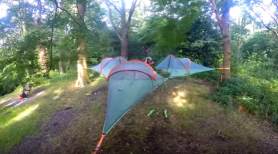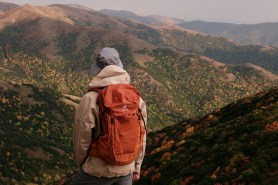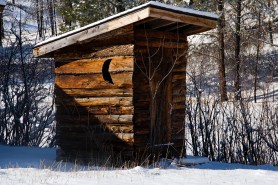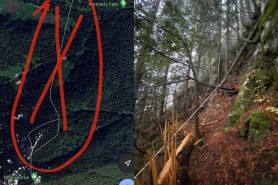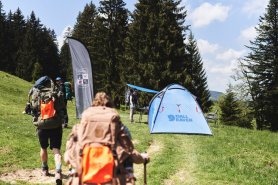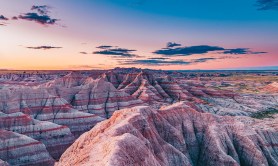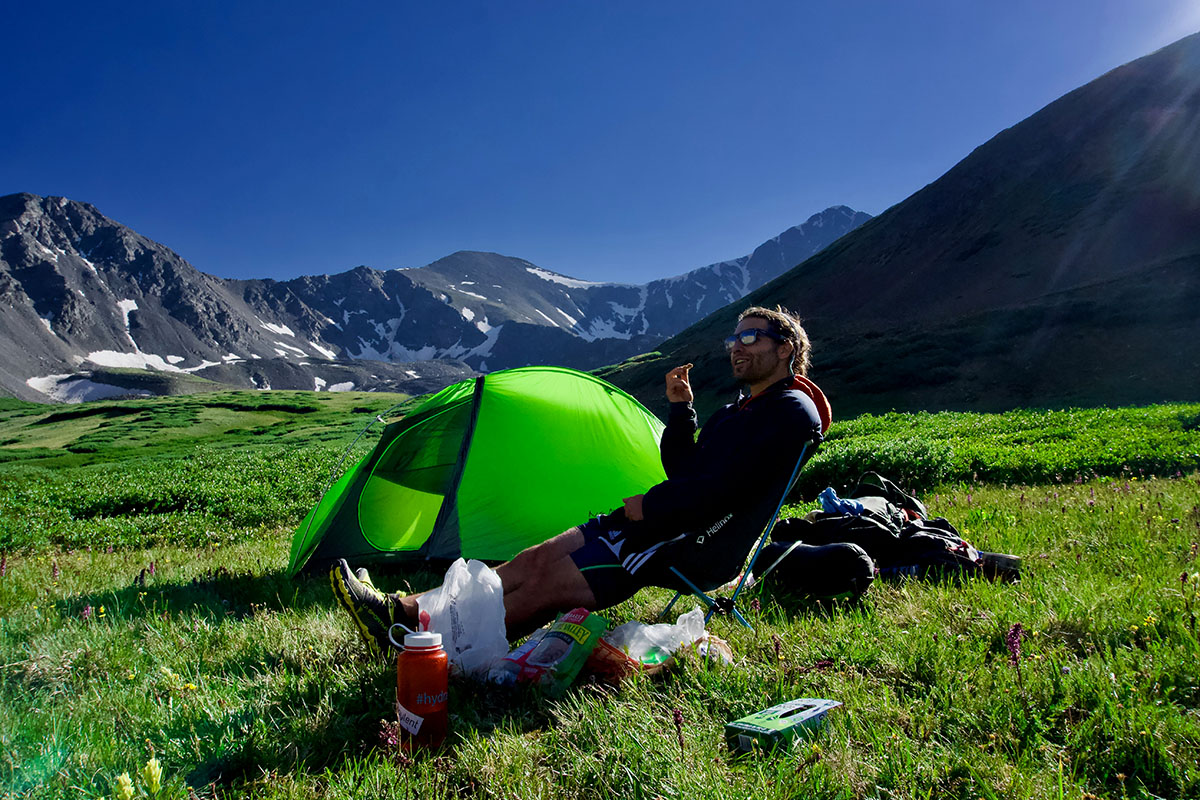

Whenever you and your adventure buddy decide it is time to go on a backpacking trip, choosing a tent is one of the most important decisions you will make. It will be your safe place for the duration of the trip, whether it’s a long hike or a quick weekend getaway.
Videos by Outdoors
Our top pick for a two-person backpacking tent was the Big Agnes Copper Spur HV UL2. This tent offers exceptional protection in all weather conditions, and is super light to carry to scenic spots on backpacking trips.
Two budget backpacking tents we recommend, are the Kelty Late Start or the Marmot Crane Creek. Both offer durability, comfort and easy set-ups, which makes them perfect tents for exploring.
This post contains affiliate links. Outdoors.com may earn a commission when you make a purchase through these links. Thank you for your support.
The Best 2 Person Tents for Backpacking in 2024
- Best Overall 2-Person Backpacking Tent – Big Agnes Copper Spur HV UL2
- Best Three-Season 2-Person Backpacking Tent – REI Co-op Trail Hut 2
- Best Spacious 2-Person Tent – REI Half Dome SL 2+
- Best Waterproof 2-Person Tent – REI Co-op Trailmade 2
- Best Sustainable 2-Person Tent – Big Agnes Tiger Wall UL2 Solution Dye
- Best Four-Season 2-Person Backpacking Tent – The North Face Mountain 25
- Best Durable 2-Person Backpacking Tent – NEMO Dagger OSMO 2
- Best Ultralight Backpacking Tent for 2 people – MSR FreeLite 2
- Best Comfortable 2-Person Tent – Marmot Crane Creek 2P
- Best Budget 2-Person Tent – Kelty Late Start 2P
Best Overall 2-Person Backpacking Tent – Big Agnes Copper Spur HV UL2
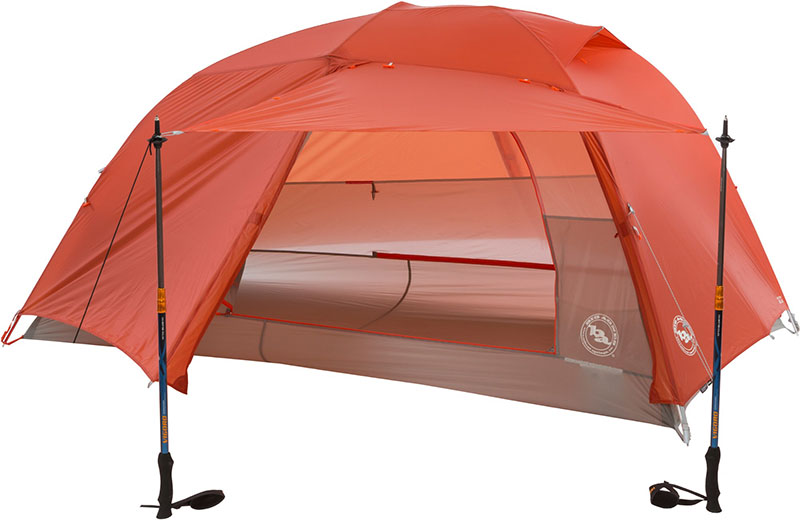
Specs:
- Packed Weight: 3lbs 2oz
- Packed Size: 6 x 19.5 inches
- Floor Area: 29 square feet
Expertly designed, the Big Agnes Copper Spur HV is an ultralight backpacking tent that will make your adventure extra enjoyable with a range of useful features.
It has two awning-style vestibules on each side, a great addition for storage or protection from the sun or drizzle. Made from lightweight double ripstop nylon, its quality construction offers extra tear strength.
The interior has several pockets, including an oversized media pocket with a headphone slot for wired headphones, and two small pockets near the doors.
The Copper Spur has overwhelmingly positive user reviews, with customers mentioning the tent’s durability. According to customers, it has withstood extreme weather and varying terrains, from heavy hail in the Eastern Sierra to thunderstorms in New Zealand.
Check out more picks for best ultralight tents.
Best Three Season 2-Person Backpacking Tent – REI Co-op Trail Hut 2

Specs:
- Packed Weight: 5 lbs 15 oz.
- Packed Size: 8 x 18 inches
- Floor Area: 31.7 square feet
We’ve picked three REI Co-Op tents for our list. We like all three for their great value for money and price-to-performance ratio. This one is perfect for backpackers, with its easy setup and spacious living area, perfect for two people.
It has a freestanding dome architecture and a ridge pole to support door walls, allowing for increased space inside. The yellow shade makes it noticeable and easy to find.
Although it’s not an ultralight tent to carry, the tent canopy, made from polyester, lasts well in wet and windy weather. There is extra coverage from a rainfly, made from coated nylon taffeta. It also comes with a footprint and it is easily packed away in a stuff sack.
Best Spacious 2-Person Camping Tent – REI Half Dome SL 2+
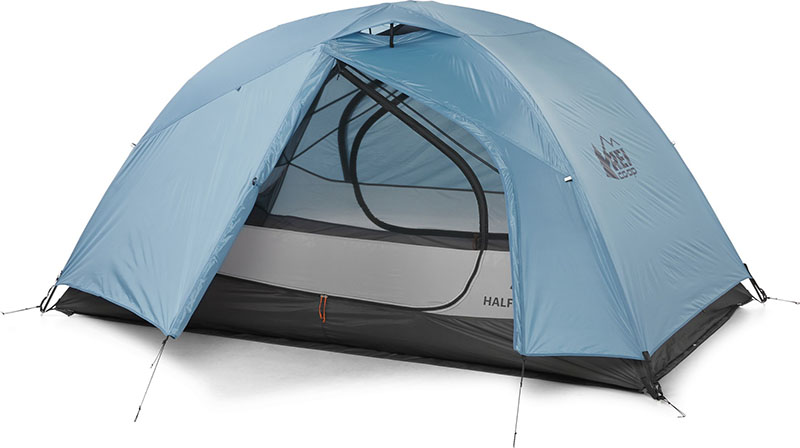
Specs:
- Packed Weight: 4lbs 11.5oz
- Packed Size: 7 x 20.5 inches
- Floor Area: 33.75 square feet
The second REI co-op tent to make our list is the Half Dome SL 2+, another versatile, affordable, and lightweight choice.
This one is an updated version of the previous Half Dome SL, a much-loved tent in the outdoors community. With color-coded poles and easy-to-follow instructions, this tent is quick to assemble.
The floor space includes room for two and gear, or a furry friend, with vertical tent walls providing extra height and space. It has a useful single-pole design and has two vestibules and an overhead pocket for storage. The tent has large vents and mesh panels for breathability and to prevent condensation.
It is made from 40-denier ripstop nylon and 20-denier nylon mesh. It offers good protection from the elements, but you might want to consider something a little more durable for extreme weather camping.
Best Waterproof 2-Person Tent for Wet Weather – REI Co-op Trailmade 2
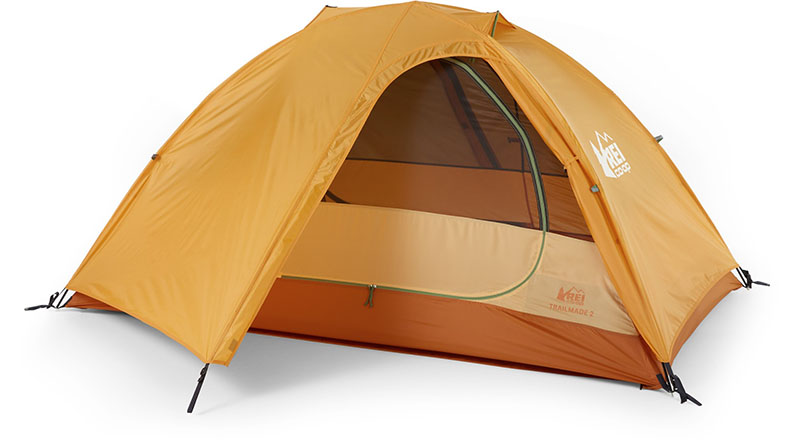
Specs:
- Packed Weight: 5 lbs 7 oz
- Packed Size: 8.5 x 22 inches
- Floor Area: 31.7 square feet
Our third and final pick from REI is the Trailmade 2, which is another comfortable and great value option for backpackers. It is easy to set up and break down with its x-pole configuration. The interior has pockets for gear storage.
It comes in the shade Desert Sun, an attractive three-tone color that is easy to spot. A rectangular floor plan makes it feel roomy and spacious for two.
There is ample space for all your stuff, with a covered area. It comes with a rain fly made from coated polyester to keep you dry when camping in inclement weather.
Best Sustainable 2-Person Tent – Big Agnes Tiger Wall UL2 Solution Dye

Specs:
- Packed Weight: 2 lbs 8oz
- Packed Size: 5.5 x 18 inches
- Floor Area: 28 square feet
The Big Agnes Tiger Wall UL 2 is a technical backcountry tent, it is easy to set up with a single-pole system and has two doors with vestibules. These ultralight tents are so easy to pack and carry on hikes, the tent also has a 3D-bin mezzanine at the foot, for additional storage.
One of the coolest features is the LED lights integrated into the tent seams. No need to pack bulky camping lamps, these lights will be helpful for sorting gear, playing cards or hanging out at night.
The fabric is solution-dyed and highly resistant to UV fade. This sustainable method reduces energy consumption by 80% and water use by 50% during the manufacturing process.
Best Four-Season 2-Person Backpacking Tent – The North Face Mountain 25 Tent
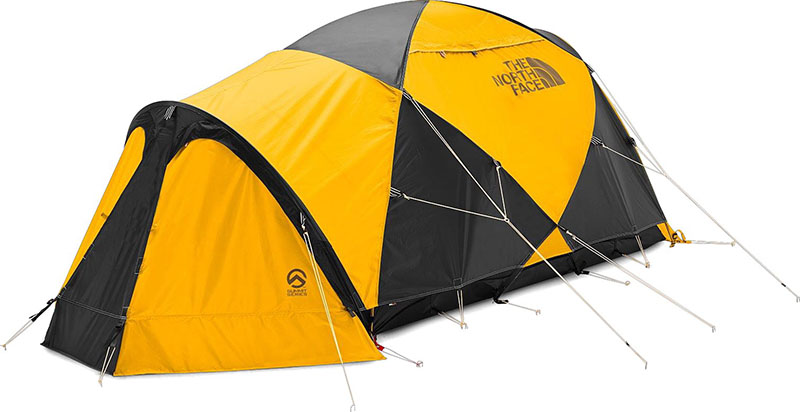
Specs:
- Packed Weight: 4lbs 1oz
- Packed Size: 6 x 18 inches
- Floor Area: 29 square feet
The MSR Access 2 is a versatile freestanding tent designed for mountaineering which protects against extreme weather. This four-season tent provides a little extra warmth than most backpacking tents, providing comfort and protection in cold conditions.
The central support frame and polyurethane waterproof coating on the rainfly and floor work together to provide lots of protection from rain and snow. There is limited mesh on the canopy to keep in the warmth, with vents in the rainfly to reduce condensation.
The floor plan provides ample room and a generous peak height of 42 inches in the interior. It’s compact, but you and your adventure buddy will enjoy the extra head space.
Best Durable 2- Person Backpacking Tent-NEMO Dagger OSMO 2
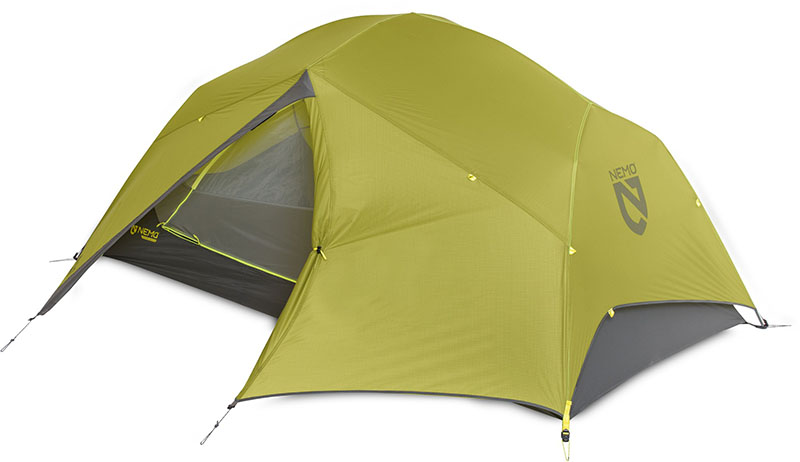
Specs:
- Packed Weight: 3lbs 6oz
- Packed Size: 19.5 x 6.5 x 3.5 inches
- Floor Area: 31.3 square feet
NEMO’s Dagger Osmo tent is designed with a combination of practicality and peak performance on the trails in mind.
It is made from Osmo polyester/nylon ripstop fabric. A sustainable choice on the tent market, this fabric is extremely durable. It has sturdy poles and stakes, so you can be sure the tent will stay in place even in extreme weather.
The setup is intuitive and color-coded for ease. With plenty of pockets for storage and vestibules for leaving gear dry overnight, the design is well-thought-out. There is even a nightlight pocket for a night lamp. Roomy on the inside, it is the perfect size for two campers.
Best Lightweight 2-Person Backpacking Tent – MSR FreeLite 2

Specs:
- Packed Weight: 2lbs 5oz
- Packed Size: 4.5 x 18 inches
- Floor Area: 29 square feet
An unbelievably lightweight tent, the MSR Freelite 2 is designed for backpackers who do not want to be weighed down. The ultralight tent’s trail weight is just under two pounds, making it the perfect tent for anyone likely to carry a tent for long periods.
It’s a semi-free standing option which is very easy to set up. It has a rectangular floor plan with pockets and cord slots for all your technological devices.
The poles are made from lightweight aluminum, the tent body is micromesh, and the rainfly is waterproof DuraShield polyurethane. All of these materials are durable and contribute to its ultralight design.
Best Comfortable 2-Person Tent – Marmot Crane Creek 2P/3P
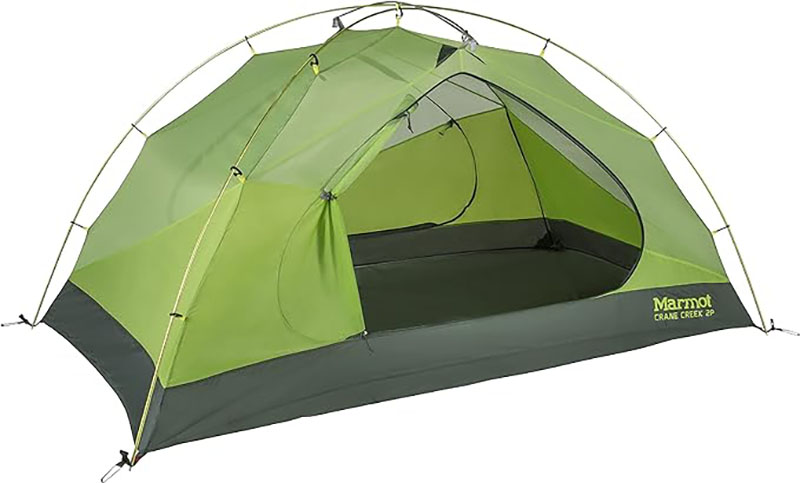
Specs:
- Packed Weight: 5lbs
- Packed Size: 22 x 5.5 x 4.5 inches
- Floor Area: 32 square feet
The Marmot Crane Creek is a durable, comfortable option for cozy nights on the trails. It fits two adults easily with space for gear. Although it adds a little extra bulk to your backpack, the extra space will be worth it for some.
Though it is an expensive option, this tent offers a great selection of features. Waterproof and reliable, the tent can be useful for backpacking, festivals, car camping, and lots of other outdoor activities.
The Crane Creek has a seam-taped floor which prevents leaks, and sturdy aluminum poles add strength to the construction. It has two large D-shaped doors with two spacious overhead vestibules and pouches inside for storage.
Best Budget 2-Person Tent – Kelty Late Start 2P
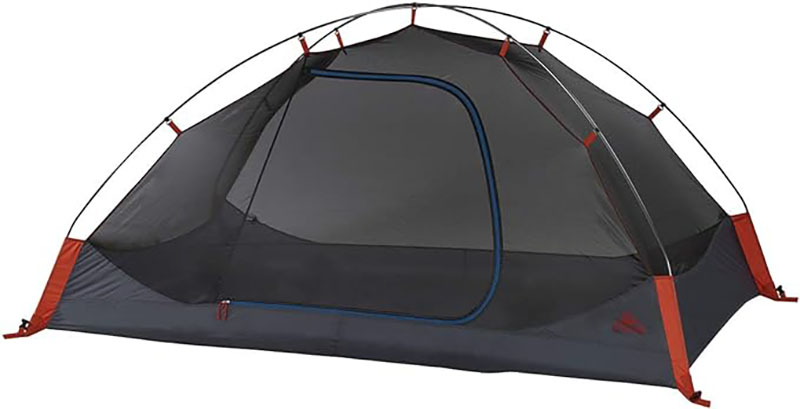
Specs:
- Packed Weight: 4lbs 8oz
- Packed Size: 16 x 7 x 7 inches
- Floor Area: 29.5 square feet
This tent is the most inexpensive on our list, and there are a few reasons why we think it’s good value for money.
Firstly, Kelty is known for making good quality camping gear at a reasonable price. The Late Start is reasonably lightweight for its low price.
It is super easy to set up. It can be ready to go, even for first-timers, in under five minutes. The Late Start is made from 68D polyester fabric and the tent’s body is protected by a 68 denier rain fly, making it very effective in heavy rain.
It has excellent ventilation for hot days, and an interior peak height of 40 inches, so there is plenty of room inside.
Two-Person Backpacking Tents: A Buyer’s Guide
It’s important to check the specifications of your tent carefully to make sure the tent has everything you need for your backpacking trip.
Check out our picks for the best backpacking tents.
The Main Components of a Tent
Tent Body
The tent body (or canopy or inner tent) is the main fabric structure of the tent. It protects against weather conditions, as well as providing shelter and comfort.
It will usually be made from a lightweight, durable material such as nylon, polyester, or ripstop nylon. These materials are known for their strength and resistance to abrasion, and they also can provide water resistance and sun protection.
The tent body will also have mesh panels incorporated into the structure for ventilation. This enhances airflow, reduces condensation, and it helps keep bugs and insects out.
Tent Poles and Stakes
The tent poles provide a structural framework for the tent, keeping it stable and upright. Tent stakes (or pegs) are used to keep the tent in the ground by anchoring the tent corners. They are attached through loops, preventing the tent from being blown away in the wind.
Poles and stakes are usually made from strong, lightweight materials that are easy to carry, such as aluminum.
Rainfly
Always make sure your tent has a rainfly for protection against wind and rain. The rainfly is an additional waterproof cover that goes over the tent’s body. The rainfly should provide adequate coverage, extending over all openings and down to the ground.
Footprint
The footprint, sometimes known as the groundsheet, is an additional layer between the tent floor and the ground. It offers extra protection and waterproofing against ground moisture.
Some tent brands will include a footprint in the packaging, but other times you will need to purchase the footprint separately. It is very important to have one if you will be setting up your tent on rough or rocky terrain.
Vestibules
Vestibules are extensions of the rainfly that create additional covered space outside the tent for storing gear. They help keep gear dry and provide a buffer against rain entering the tent when you enter or exit.
Interior pockets
Check for additional storage features that will help to optimize a compact space. Media pockets, for storing electronic devices, can be very handy. Pockets on the sides might also include headphone or cord slots, and storage for headlamps.
Tent Types and Construction
All of the tents on this list are dome-shaped tents. This style offers a rounded shape held together by two or more intersecting poles that form a criss-cross shape, creating a dome.
Dome tents offer good stability, roomy interiors, and extra headroom. Their rectangular-shaped floors provide a spacious and comfortable interior. Keep an eye out for dome tents with an almost vertical wall construction. They will offer more headroom throughout the tent.
A cabin tent will feature vertical wall construction, but they are a little more bulky and less appropriate for backpacking.
Weather Resistance
Waterproof Protection
It’s worth checking that the tent is made from a durable fabric, such as nylon, ripstop nylon, or polyester.
The tent’s waterproof rating is measured in millimeters (mm). This rating indicates the fabric’s ability to resist water penetration. A higher number signifies better waterproofing. For three-season tents, a rating of at least 1,000mm is considered adequate, while higher ratings are preferred for more challenging conditions.
Check the specifications for taped seams. This feature will prevent water from coming through the tent’s stitching.
A design that includes a bathtub floor is also helpful for water protection. This is a construction that includes the sides of the floor extending up along the walls, preventing water from entering the inside of the tent.
Ventilation
Good ventilation is an important factor to consider for all types of camping. Look for tents with mesh panels and windows that provide good airflow and will reduce the amount of condensation in the tent.
Wind Resistance
Consider the tent’s design and structure for wind resistance. Sturdy poles and strong stakes will contribute to a tent’s ability to withstand windy conditions.
If you think the weather will be extreme on your backpacking trip, it might be worth adding to your budget to buy something more substantial. Search for ‘four-season’ tents that are designed to withstand high winds.
Packed Weight vs Trail Weight
For backpacking, tents should be as light as possible since you will be carrying them on your back. Look for tents that weigh somewhere between 2 – 6 pounds when packed. There are usually two weights noted on the product’s specifications: the trail weight and the packed weight.
The trail weight (or minimum trail weight) is the weight of the tent, rainfly, and poles. There is usually a difference of a few pounds. Some tents offer a few packing options, so you can share the weight between multiple sacks.
The packed weight refers to the entire weight of the tent package when it is purchased, including everything that comes with the tent.
The packed dimensions are also useful to note, so you can determine whether the tent can fit inside your backpack.
Season Rating
Most tents are either three-season tents or four-season tents.
Three-season tents are suitable for use in spring, summer, and fall, and four-season tents can survive winter and extreme weather conditions.
Freestanding vs Non-Freestanding Backpacking Tents
Freestanding tents do not require stakes to stand. They can stand on their own with the need for stakes to hold them in the ground, making them easy to assemble. Semi-freestanding tents require some of their parts to be staked to the ground.
Nonfreestanding tents need to be secured in the ground, so their set-up is not as quick and easy. However, these tents are often more lightweight with a simpler design.
Ease of Setup
An easy setup can save lots of time on your backpacking adventure, allowing you more time to relax and enjoy your surroundings. Look for tents with color-coded poles and a simple construction.
Interior Space
It’s important to check the floor dimensions of a tent to see how spacious it is for two campers with a sleeping bag each and gear. The manufacturer will note this information in the description in square feet.
You should also check the peak height to get a sense of how much headroom the tent offers. Rectangular floor plans with vertical walls offer the most interior space. This makes it easier to arrange sleeping bags and belongings.
User Reviews and Brand Reputation
User reviews are useful for gaining insight into how a tent performs in the real world. Look for feedback from campers who have used the tent in similar weather conditions.
Consider the reputation of the tent manufacturer. Established outdoor gear brands with a history of producing reliable products may be more likely to offer well-designed and weather-resistant tents.
Frequently Asked Questions
How Do I Choose The Correct Size of Tent?
Check the floor dimensions and the interior’s peak height. Most two-person tents measure between 28 – 33 square feet, which will offer a snug, but comfortable fit for two.
Consider tents with good storage features for all your extra backpacking gear, including waterproof vestibules and internal pockets. Read user reviews to see how other customers find the space.
Does the Tent Come with a Warranty?
Check with the manufacturer to see if it provides a warranty for the tent. Some reputable brands will offer a lifetime warranty to provide customers with peace of mind regarding the tent’s quality.
Can I Use the Tent for Stargazing?
If it’s dry, the rainfly can usually be removed or rolled back. This can be a lovely feature if you want to do some stargazing at night.
How Much Should I Spend on a Tent?
The tents on this list are priced between $150 and $700. Your budget will depend on several factors, including the weather conditions you will experience and how often you intend to use the tent.
Remember, investing in a higher-quality tent may be worth it in the long run. Think about your budget carefully and find a tent that offers the best combination of features within that price range.
Final Thoughts
Choosing a tent is one of the most important purchases you will make for a backpacking trip. There are many options out there, so finding the right one will come down to your tent’s intended use, predicted weather conditions, and the amount of space you think you will need.
It’s worth researching the best backpacking tents before you make up your mind. Read reviews and learn from other campers’ experiences with tents.
Think carefully about your budget, and don’t just opt for the cheapest one you can find. We believe a great backpacking tent is a worthwhile investment, one that provides a home away from home in the great outdoors.


